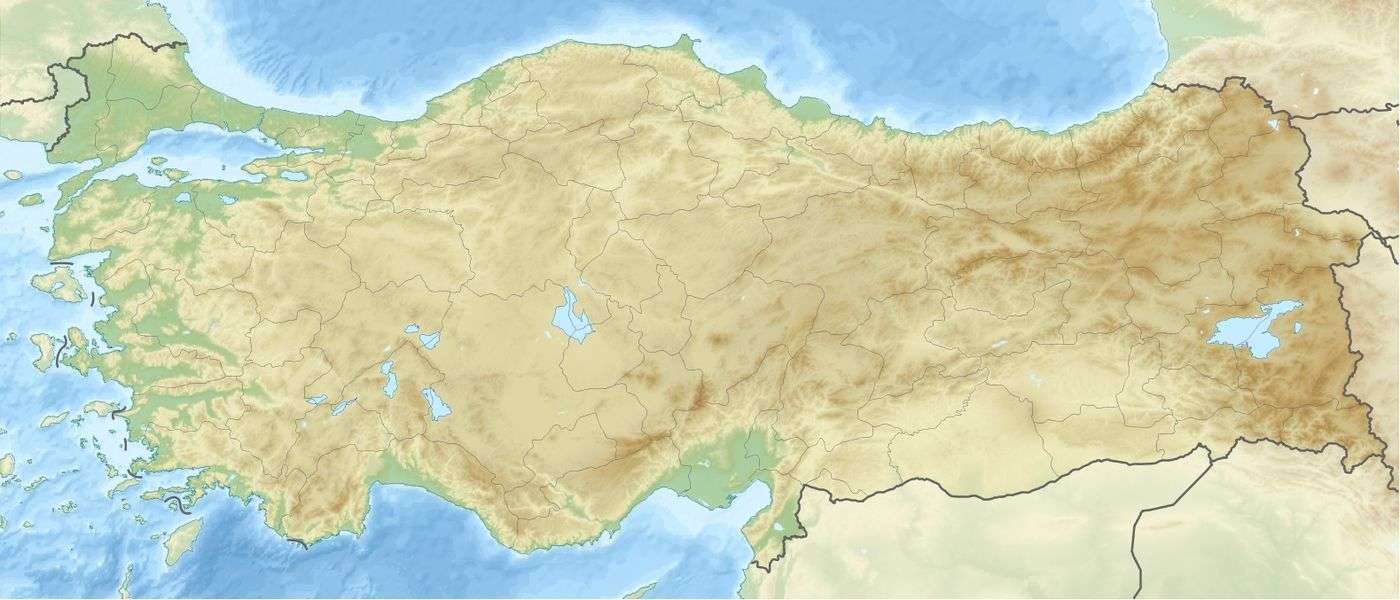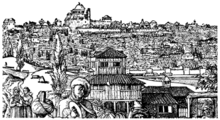1509 Constantinople earthquake
 | |
 | |
| Date | 10 September 1509 |
|---|---|
| Magnitude | 7.2 Ms |
| Epicenter | 40°54′N 28°42′E / 40.9°N 28.7°ECoordinates: 40°54′N 28°42′E / 40.9°N 28.7°E[1] |
| Areas affected | Ottoman Empire |
| Casualties | 10,000 |
The 1509 Constantinople earthquake, referred to as "The Lesser Judgment Day" (Turkish: Küçük Kıyamet or Kıyamet-i Suğra) by contemporaries, occurred in the Sea of Marmara on 10 September 1509 at about 10pm. The earthquake had an estimated magnitude of 7.2 ± 0.3 on the surface wave magnitude scale.[2] A tsunami and forty-five days of aftershocks followed the earthquake. Over a thousand houses and 109 mosques were destroyed, and an estimated 10,000 people died.
Background
The Sea of Marmara is a pull-apart basin formed at a releasing bend in the North Anatolian Fault, a right-lateral strike-slip fault. This local zone of extension occurs where this transform boundary between the Anatolian Plate and the Eurasian Plate steps northwards to the west of Izmit from the Izmit Fault to the Ganos Fault. The pattern of faults within the Sea of Marmara basin is complex but near Istanbul there is a single main fault segment with a sharp bend. To the west, the fault trends west-east and is pure strike-slip in type. To the east, the fault is NW-SE trending and shows evidence of both normal and strike-slip motion.[3] Movement on this fault, which bounds the Çınarcık Basin, was the most likely cause of the 1509 event.[2]

Damage
The area of significant damage (greater than VII (Very strong)) extended from Çorlu in the west to Izmit in the east. Galata and Büyükçekmece also suffered severe damage. In Constantinople many houses collapsed, chimneys fell and walls cracked. The newly built Bayezid II Mosque was badly damaged; the main dome was destroyed and a minaret collapsed. The Fatih Mosque suffered damage to its four great columns and the dome was split. The former church of Hagia Sophia survived almost unscathed, although a minaret collapsed. Inside the mosque, the plaster that had been used to cover up the Byzantine mosaics inside the dome fell off, revealing the Christian images.[2]
The number of dead and injured is hard to estimate, with different sources giving accounts varying from 1,000 to 13,000. It is believed that some members of the Ottoman dynasty died in this earthquake. Earthquake shocks continued for 45 days after the big earthquake, and people were unable to return to their homes for 2 months.

Characteristics
Earthquake
From the area and intensity of shaking, a 70 km (43 mi) fault rupture has been estimated.[2]
Tsunami
A tsunami is mentioned in some sources with a run-up of greater than 6.0 m (19.7 ft), but discounted in others.[2] A turbidite bed whose deposition matches the date of the earthquake has been recognised in the Çınarcık Basin.[4]
See also
References
- ↑ Ambraseys, N.N.; Jackson J.A. (2000). "Seismicity of the Sea of Marmara (Turkey) since 1500". Geophysical Journal International. 141 (3): F1–F6. Bibcode:2000GeoJI.141F...1A. doi:10.1046/j.1365-246x.2000.00137.x.
- 1 2 3 4 5 Ambraseys, N. N. (December 2001). "The Earthquake of 1509 in the Sea of Marmara, Turkey, Revisited" (PDF). Bulletin of the Seismological Society of America. Seismological Society of America. 91 (6): 1397. Bibcode:2001BuSSA..91.1397A. doi:10.1785/0120000305.
- ↑ Armijo, R.; Meyer B.; Navarro S.; King G. & Narka A. (2002). "Asymmetric slip partitioning in the Sea of Marmara pull-apart: a clue to propagation processes of the North Anatolian Fault?" (PDF). Terra Nova. 14 (2): 80–86. doi:10.1046/j.1365-3121.2002.00397.x. Retrieved 2010-02-06.
- ↑ Lozefski, G.; McHugh C.; Cormier M-H.; Seeber L.; Çagatay N.; Okay N. (2004). "Provenance of turbidite sands in the Marmara Sea, Turkey: a tool for submarine paleoseismology". Retrieved 6 February 2010.